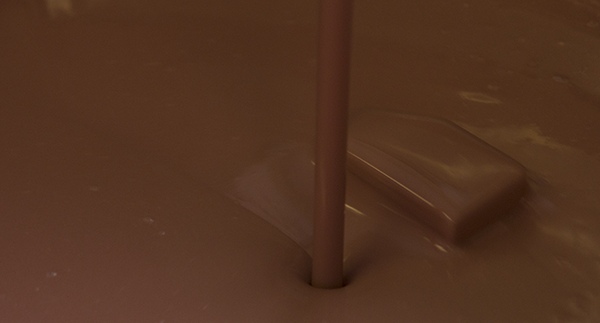We all know the importance of tempering chocolate. A bad temper can ruin the texture of the chocolate, leading to a dull, uneven colour profile, and a waxy, crumbly texture. But get it right, and you get a smooth, silky texture, a glossy finish, and a satisfyingly clean snap when you break the chocolate.
Most manufacturers will provide recommended working temperatures for their chocolate grades on the packaging itself. These figures are great starting points, however, they should only be used for guidance, as a range of variables, from differences in environment to differences in the individual machine configuration you have, can affect the ideal tempering temperature. Here’s a quick guide on finding the perfect tempering temperature for your chocolate –we’ll go through the starting temperatures for different types of chocolate, and then cover how to pinpoint the perfect tempering temperature for your chocolate.
How to Temper Mainstream Chocolates
Standard grade chocolates from big-name industrial producers like Callebaut are usually designed to be easy to temper. They typically temper at around the same temperatures: 31˚c – 32˚c for plain chocolate, 30˚c – 31˚c for milk chocolate and 29.5˚c – 30˚c for white chocolate. If you’re using our Infinity AX tempering machine, you won’t need to make any additional adjustments for standard chocolate grades – just set the temperature and get started, and you’ll have perfectly tempered chocolate.
Tempering Bean-to-bar or Craft Chocolates
These chocolates often have a larger particle size, as well as significantly different fat contents, which can have a huge effect on tempering. If they do not contain lecithin to function as an emulsifier, this can lead to the chocolate being more temperamental. This is why it’s so important to test carefully to find the ideal temperature for tempering. The best temperatures to start with when tempering these types of chocolate are 1˚c higher than those used for mainstream chocolate.
Tempering Temperatures for ‘Free-from’ or ‘Functional’ Chocolates
Substituting ingredients such as sugar and dairy for ingredients like rice flour, sweeteners, plant proteins etc., or fortifying chocolate with additions such as protein, can have a profound effect on the tempering temperature. This means it’s essential to test the tempering temperature properly before starting production. Similar to bear-to-bar and craft chocolates, the best course of action is to make your starting temperature 1˚c above mainstream chocolate temperatures as a starting point.
Viscosity, Fat Content and Dry Cocoa Solids
If your chocolate is thickening up or even solidifying during tempering, remember that the viscosity of your chocolate can also play a significant part in determining how easy your chocolate is to temper in a conventional continuous tempering machine. Viscosity is determined by the ratio of dry cocoa solids to total fat content. If there are too many dry cocoa solids, the chocolate won’t be fluid enough to temper easily. As a guide, one the Callebaut ‘drop’ scale, anything below 3-drop will generally not temper easily.
Finding the Perfect Tempering Temperature
Finding the right tempering temperature is a matter of trial and error, so make sure you have a good amount of chocolate to experiment with. We recommend starting 1˚c above the suggested temperatures and reducing the temperature by 0.2˚c each time until you achieve the optimal temper. Make sure you run a full temper cycle each time, including melting, to make sure the chocolate is fully decrystallized between each test to get accurate results.
Bear in mind that in some cases, where the exact recipe and production process can’t be easily repeated, the optimal temperature can vary from batch to batch. If this is a known issue with the type of chocolate you are using, make sure to test a sample of the batch before attempting to work with the rest of the batch. You can also make small adjustments to a specific batch without the need to re-temper.
The perfect tempering temperature may not be the same from machine to machine, as all tempering machines will differ slightly in their operating characteristics. If you are using an Infinity AX tempering machine, you can adjust the operating parameters to ensure the best possible temper even if your chocolate is a little temperamental! If you need help with this process, feel free to contact us for advice.
Finding the right tempering temperature is a process, but it’s absolutely essential to creating high-quality chocolate products. Our chocolate engineers are experts in tempering – if you need a helping hand with finding the perfect tempering temperature, or you’d like us to do it for you using a sophisticated temper meter, feel free to get in touch.
